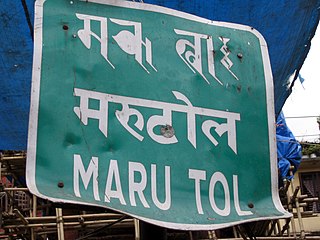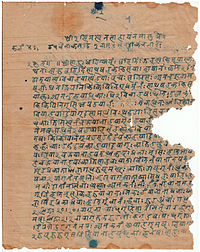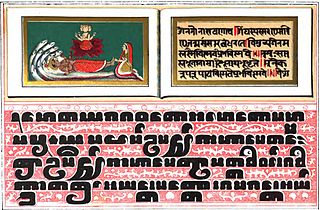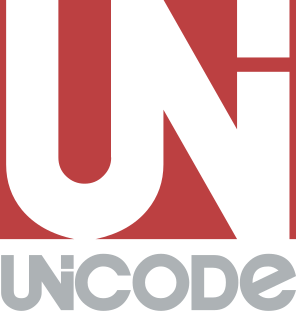The Brahmic scripts are a family of abugida or alphasyllabary writing systems. They are used throughout the Indian subcontinent, Southeast Asia and parts of East Asia, including Japan in the form of Siddhaṃ. They are descended from the Brahmi script of ancient India, and are used by languages of several language families: Indo-European, Dravidian, Tibeto-Burman, Mongolic, Austroasiatic, Austronesian, and Tai. They were also the source of the dictionary order of Japanese kana.
OpenType is a format for scalable computer fonts. It was built on its predecessor TrueType, retaining TrueType's basic structure and adding many intricate data structures for prescribing typographic behavior. OpenType is a registered trademark of Microsoft Corporation.
The Balinese script, natively known as Aksara Bali and Hanacaraka, is an alphabet used in the island of Bali, Indonesia, commonly for writing the Austronesian Balinese language, Old Javanese, and the liturgical language Sanskrit. With some modifications, the script is also used to write the Sasak language, used in the neighboring island of Lombok. The script is a descendant of the Brahmi script, and so has many similarities with the modern scripts of South and Southeast Asia. The Balinese script, along with the Javanese script, is considered the most elaborate and ornate among Brahmic scripts of Southeast Asia.

Newar, or Nepami, are the historical inhabitants of the Kathmandu Valley and its surrounding areas in Nepal and the creators of its historic heritage and civilisation. Newars form a linguistic and cultural community of primarily Indo-Aryan and Tibeto-Burman ethnicities following Hinduism and Buddhism with Newari as their common language. Newars have developed a division of labour and a sophisticated urban civilisation not seen elsewhere in the Himalayan foothills. Newars have continued their age-old traditions and practices and pride themselves as the true custodians of the religion, culture and civilisation of Nepal.

A few projects exist to provide free and open-source Unicode typefaces, i.e. Unicode typefaces which are open-source and designed to contain glyphs of all Unicode characters. However, there are also numerous projects aimed at providing only a certain script, such as the Arabeyes Arabic font. The advantage of targeting only some scripts with a font was that certain Unicode characters should be rendered differently depending on which language they are used in, and that a font that only includes the characters a certain user needs will be much smaller in file size compared to one with a large number of glyphs. Unicode fonts in modern formats such as OpenType can in theory cover multiple languages by including multiple glyphs per character, though very few actually cover more than one language's forms of the unified Han characters.
The Limbu script is used to write the Limbu language. It is a Brahmic type abugida.

The Rañjanā script (Lantsa) is an abugida writing system which developed in the 11th century in Nepal. It is the original script of the Newar language and is used till this day. Nowadays it is also used in Buddhist monasteries in India, China, especially in the Tibetan Buddhist areas within the Tibet Autonomous Region, Sichuan, Yunnan, Qinghai and Gansu, Mongolia, and Japan. It is normally written from left to right but the Kutakshar form is written from top to bottom. It is also considered to be the standard Nepali calligraphic script.
In Unicode, a Private Use Area (PUA) is a range of code points that, by definition, will not be assigned characters by the Unicode Consortium. Currently, three private use areas are defined: one in the Basic Multilingual Plane (U+E000–U+F8FF), and one each in, and nearly covering, planes 15 and 16. The code points in these areas cannot be considered as standardized characters in Unicode itself. They are intentionally left undefined so that third parties may define their own characters without conflicting with Unicode Consortium assignments. Under the Unicode Stability Policy, the Private Use Areas will remain allocated for that purpose in all future Unicode versions.

Tirhuta or Mithilakshar is the script used for the Maithili language originating in the Mithila region of Bihar, India and the eastern Terai region of Nepal. The oldest reference to Tirhuta script is Sahodara Temple of Narkatiyaganj, Bihar, dated 950 CE The script has a rich history spanning a thousand years, believed to be originated in the 10th century CE, but years of neglect by Nepal and the Bihar government have taken their toll on the use of Tirhuta. It is similar to Assamese script and Bengali script. Most speakers of Maithili have switched to using the Devanagari script, which is also used to write neighboring Central Indic languages such as Nepali and Hindi. As a result, the number of people with a working knowledge of Tirhuta has dropped considerably in recent years.

The Lepcha script, or Róng script, is an abugida used by the Lepcha people to write the Lepcha language. Unusually for an abugida, syllable-final consonants are written as diacritics.

The expression Nepalese Scripts refers to alphabetic writing systems employed historically in Nepala Mandala by the indigenous Newars for primarily writing Nepalbhasa and for transcribing Sanskrit. There are also some claims they have also been used to write the Parbatiya (Khas) language but all Pahari languages were traditionally written with the Takri alphabet and now Devanagari.
Sorang Sompeng script is used to write in Sora, a Munda language with 300,000 speakers in India. The script was created by Mangei Gomango in 1936 and is used in religious contexts. He was familiar with Odia, Telugu and English.

In CJK computing, graphic characters are traditionally classed into fullwidth and halfwidth characters. With fixed-width fonts, a halfwidth character occupies half the width of a fullwidth character, hence the name.
The Burmese script is the basis of the alphabets used for modern Burmese, Mon, Shan and Karen.

Noto is a font family comprising over a hundred individual fonts, which are together designed to cover all the scripts encoded in the Unicode standard. As of October 2016 Noto fonts cover all 93 scripts defined in Unicode version 6.0, although less than 30,000 of the nearly 75,000 CJK unified ideographs in version 6.0 are covered. In total Noto fonts cover nearly 64,000 characters, which is under half of the 137,439 characters defined in Unicode 11.0.
The Gunjala Gondi lipi or Gunjala Gondi script is a script used to write the Gondi language, a Dravidian language spoken by the Gond people of northern Telangana, eastern Maharashtra, southeastern Madhya Pradesh, and Chhattisgarh. Approximately a dozen manuscripts in the script were recovered from Gunjala, a Gond village in Adilabad district of Telangana by a team of researchers from the University of Hyderabad, led by Professor Jayadheer Tirumala Rao. The script and preliminary font were unveiled in early 2014.
The Pau Cin Hau scripts are two scripts, a logographic script and an alphabetic script created by Pau Cin Hau, a Tedim religious leader from Chin State, Burma. The logographic script consists of 1050 characters, which is a traditionally significant number based on the number of characters appearing in a religious text. The alphabetic script is a simplified script of 57 characters, which is divided into 21 consonants, 7 vowels, 9 final consonants, and 20 tone, length, and glottal marks. The original script was produced in 1902, but it is thought to have undergone at least two revisions, of which the first revision produced the logographic script.
Adlam is a Unicode block containing characters from the Adlam script, an alphabetic script devised during the late 1980s for writing the Fula language in Guinea, Nigeria, Liberia and other nearby countries. It was added to the Unicode Standard in June 2016 with the release of version 9.0.
Newa is a Unicode block containing characters from the Newa alphabet, which is used to write Nepal Bhasa.














